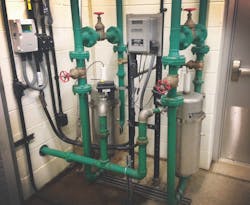When the city of Winchester (Va.) Department of Public Services underwent a major $20 million upgrade at its Percy D. Miller water treatment plant, the team saw an opportunity to correct a problem that had been bothering them for some time.
The plant pumps about 10 million gal per day to 9,400 accounts through 125 miles of pipe and draws water from the north fork of the Shenandoah River. The issue was found at the raw water pump house that sends flow to the plant about two miles away. Like most plants of its type, it uses traveling screens at the intake as the initial filtering process to keep large items and marine life from entering the high-pressure discharge main. The problem lay in the cleaning of the traveling screens. They were cleaned by spray nozzles fed from the discharge main—water that still contained particulates and plant life that would be removed later in the water treatment process. As a result, the spray nozzles kept clogging and had to be cleaned several times a day. The problem was so frustrating that the city’s staff devised a stick with nails driven through it at a spacing that matched the spray nozzles and had to use this “tool” to clean the nozzles.
“I explained the problem in detail to the engineering team from Malcolm Pirnie Eng. [now known as ARCADIS], the firm that was overseeing the upgrades,” said Corey Crabill, the plant’s chief operator. “They put their heads together to find
a solution.”
A Filtering Solution
“The obvious solution would be to run a 4-in.-diameter ductile pipe from the plant to the pump house to supply clean water,” said Glenn Rogers, chief engineer on the project. “But two miles of pipe seemed a bit of overkill. So we started looking at filtering solutions that could be installed near the pump. After all, we didn’t need potable water, just water that was particulate free.”
Rogers and his team started investigating online the options available to fill their needs.
“Most filters and screens require a lot of maintenance for filter cleaning or screen replacement,” Rogers said. “That seemed like replacing one problem with another. So we looked into automatic self-cleaning filters. [Because] they clean themselves, they virtually eliminate the need for maintenance. After research, we found a manufacturer of stainless steel self-cleaning filters and gave them a call to see if they had a product that would fit our application. It turns out they did.”
“Stainless is great for water applications,” said Dan Flanick, manager for Tekleen, manufacturer of a line of stainless steel self-cleaning filters. “The river water passes through a fine 100-μ screen. As the dirt and plant particulates accumulate on the fine screen, they begin to cause a pressure drop. In our system, we have preset the activation pressure to 7 psi. When it hits that pressure, a differential pressure switch triggers our filter controller to open 1- or 2-in. flushing valves and activates high-velocity suction nozzles that vacuum all of the accumulated particulate matter from the screen and flush it out of the system, using only a few gallons of water and taking just 10 seconds with no interruption of the main flow.”
“The two filters we got from Tekleen have more than solved our nozzle problem,” Crabill said. “We also use the filtered water as utility water and for our potassium permanganate solution. We draw the water off the header, filter it and combine it with the potassium permanganate, forming a solution that is then pumped into the discharge header, completing a loop. Since installation, we’ve had no problems, and the nozzles no longer need repeated cleaning.”
Download: Here


